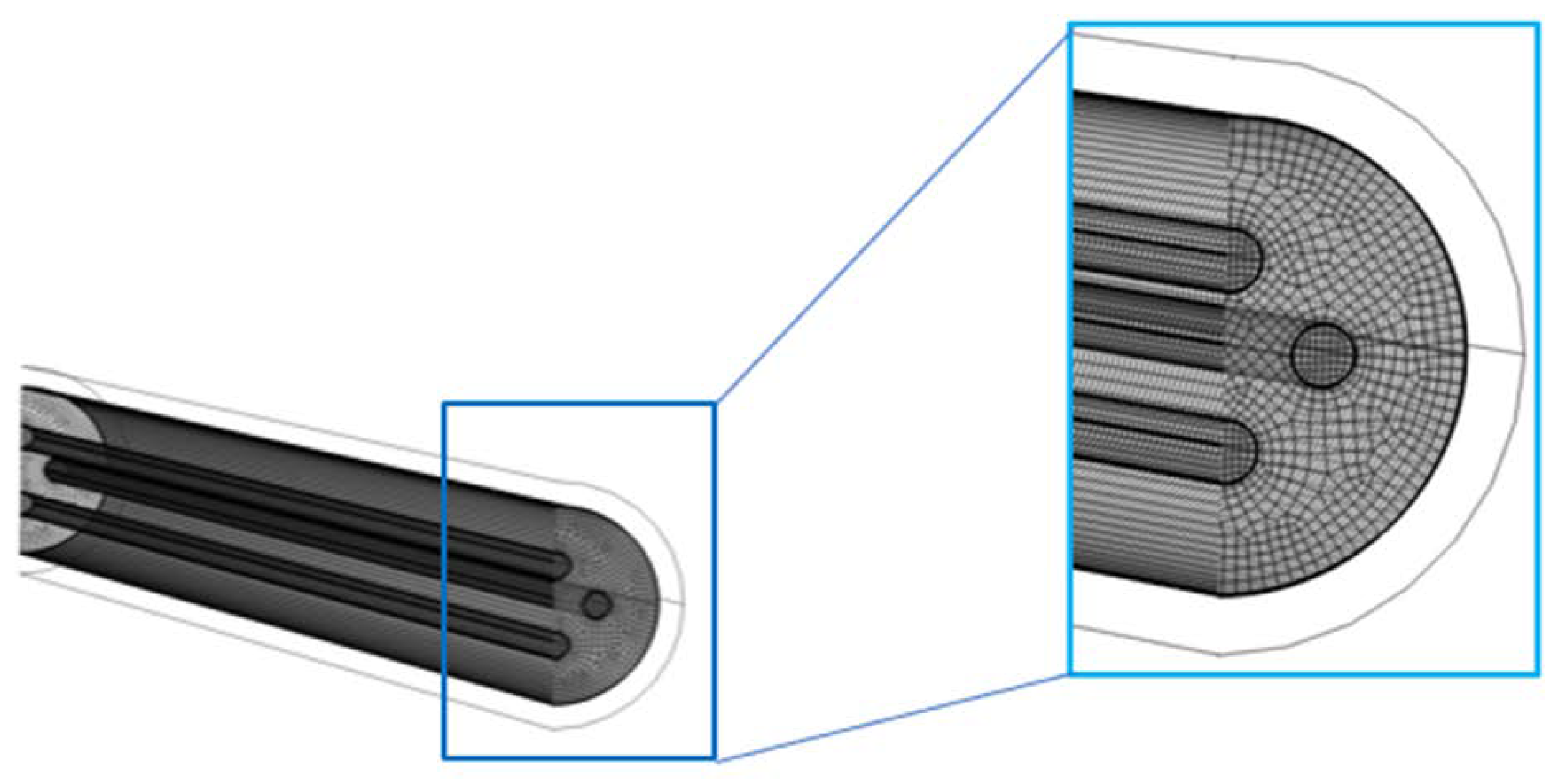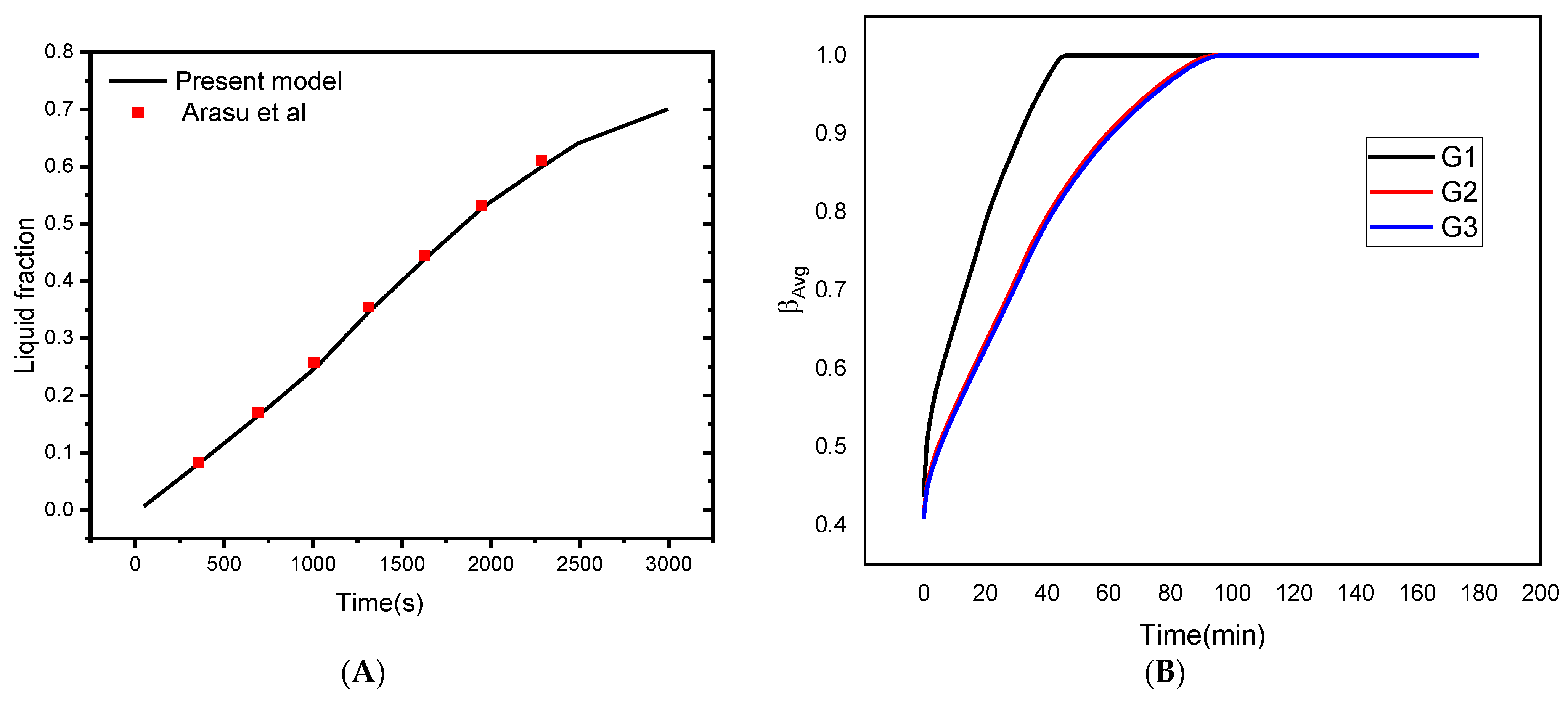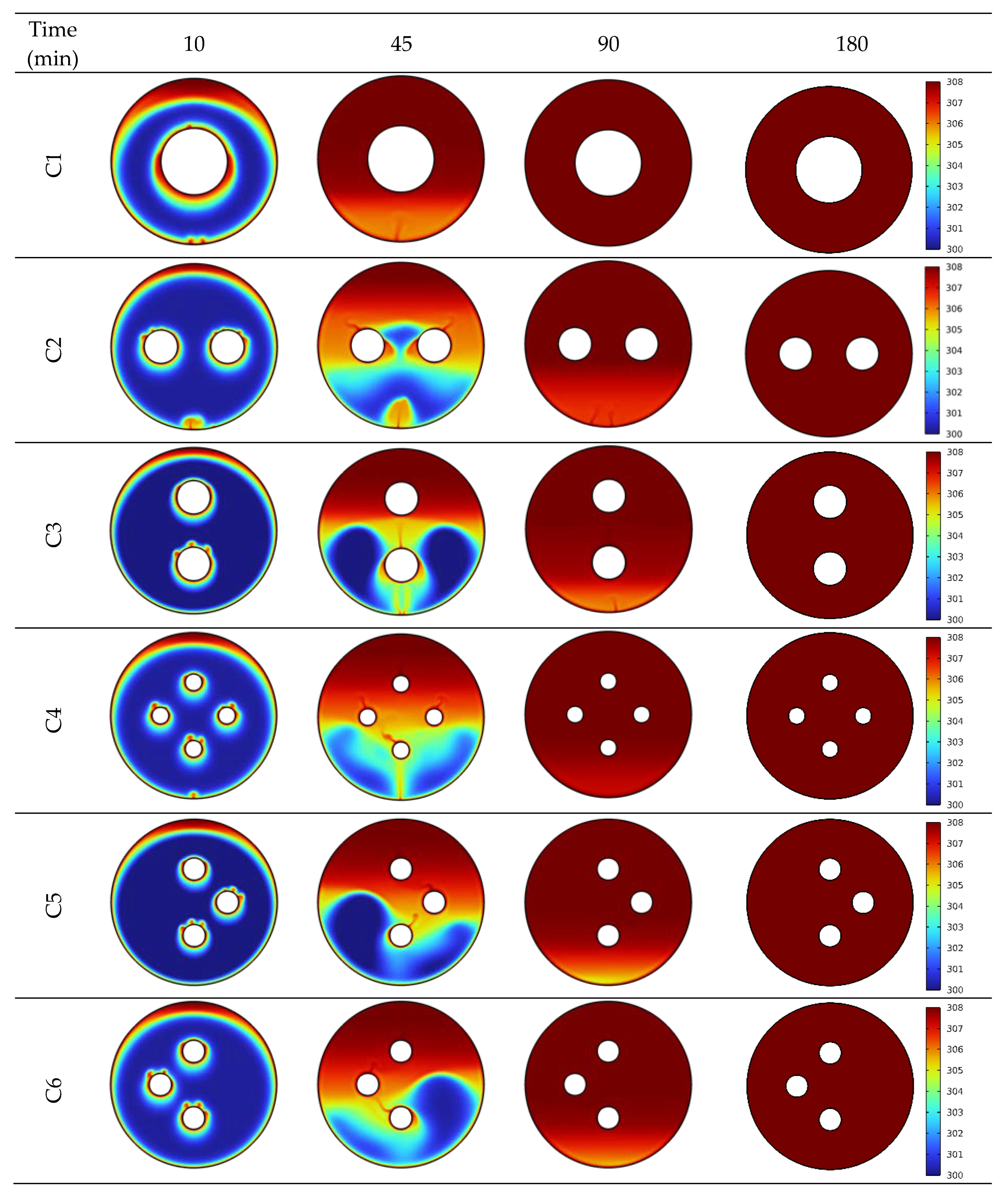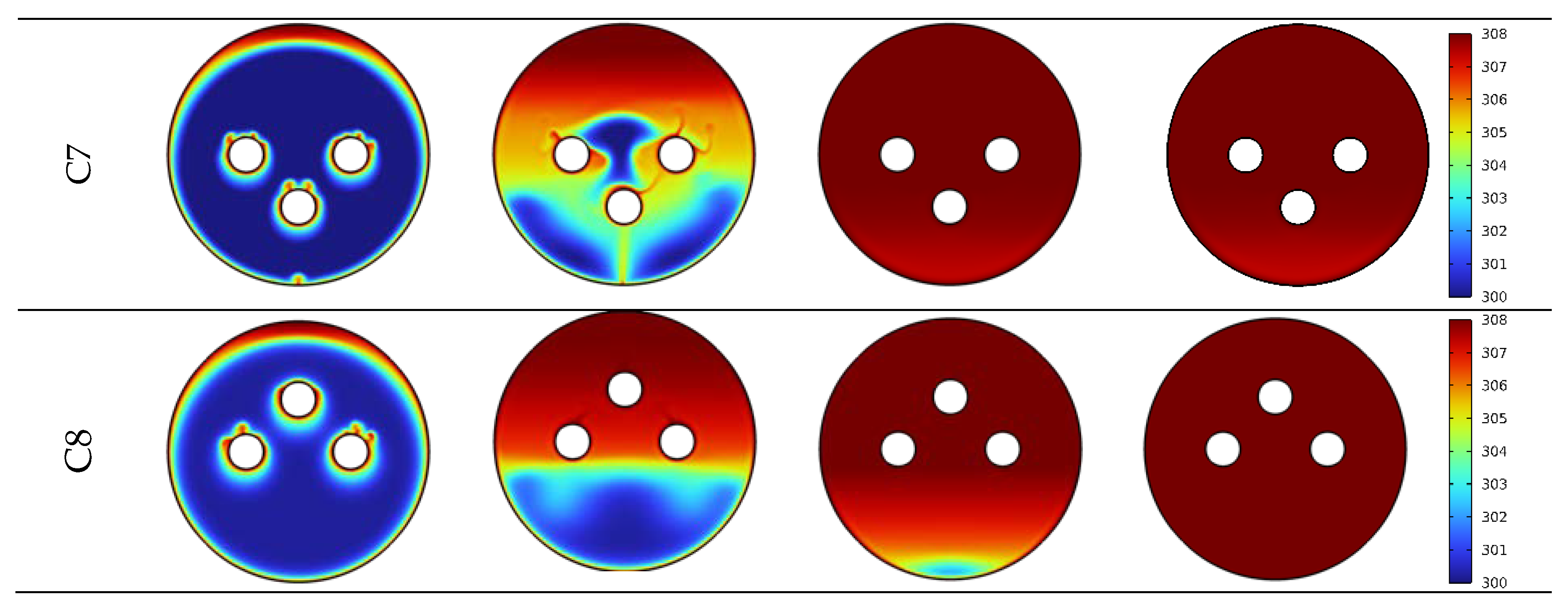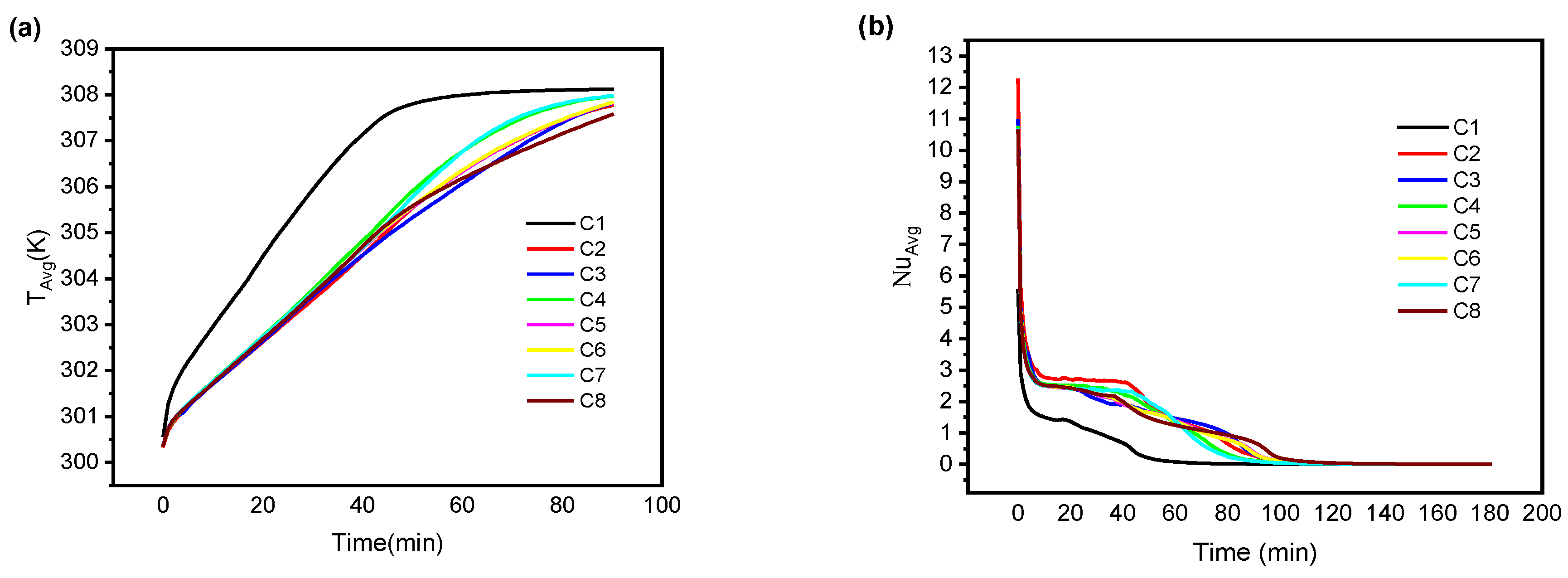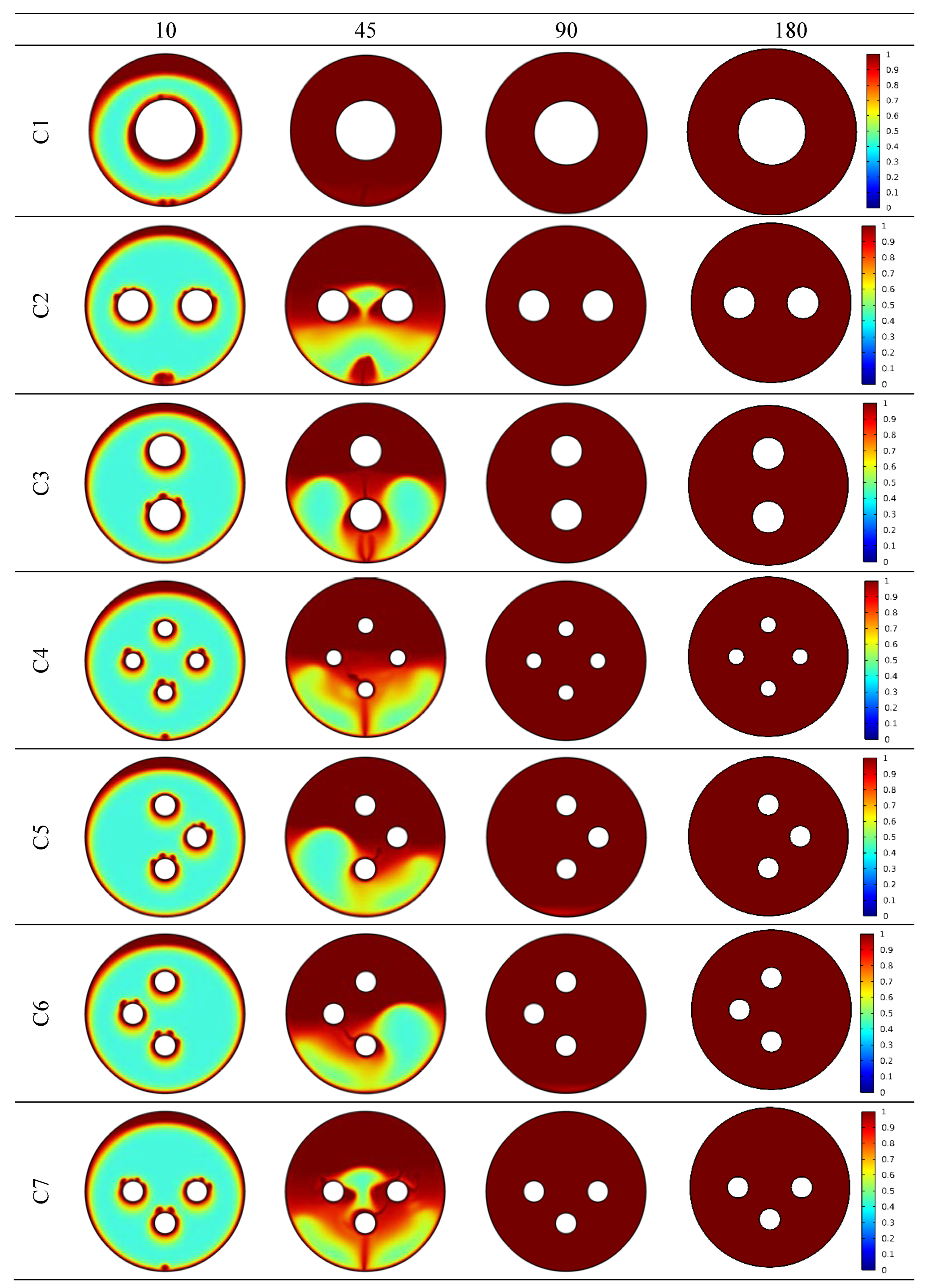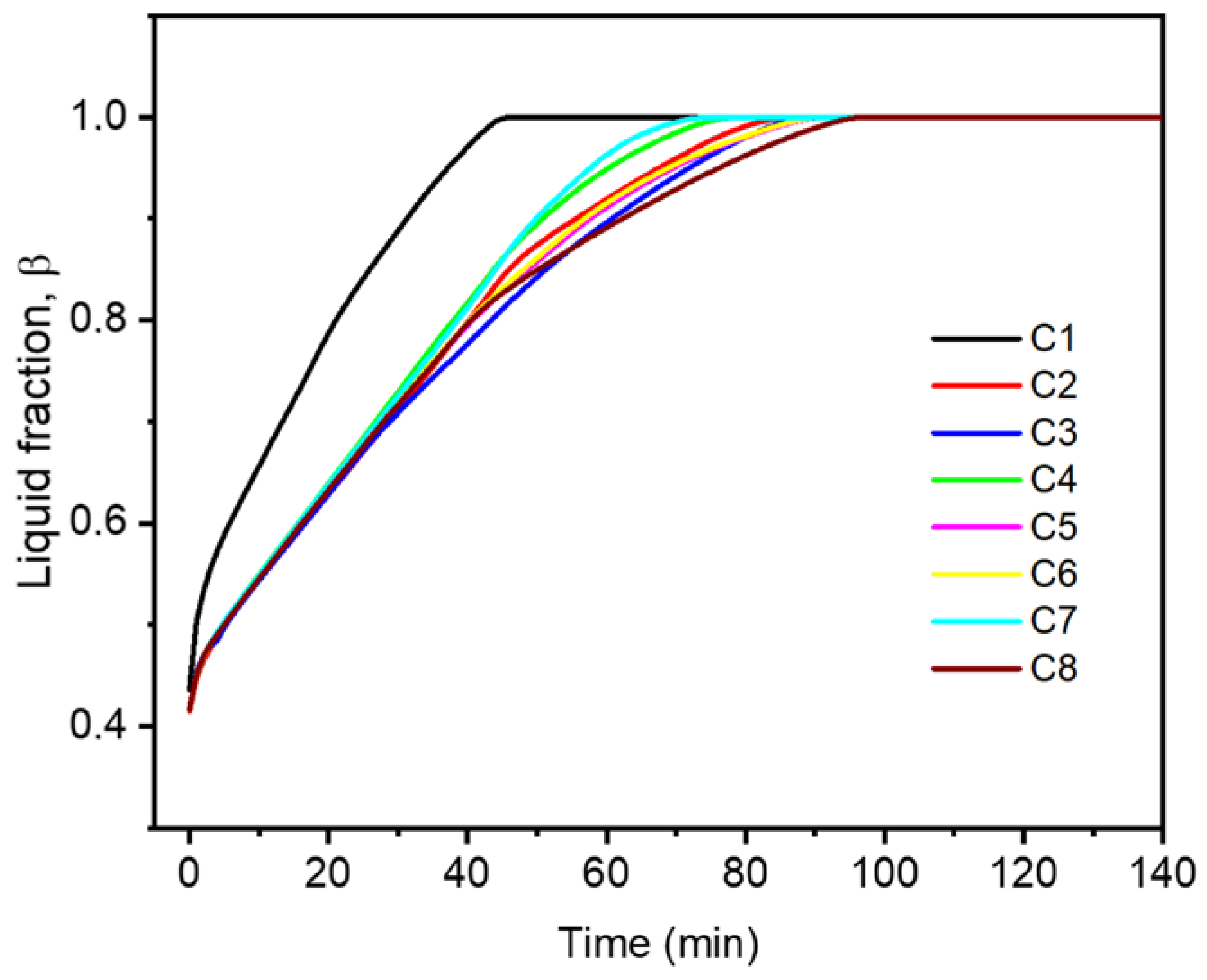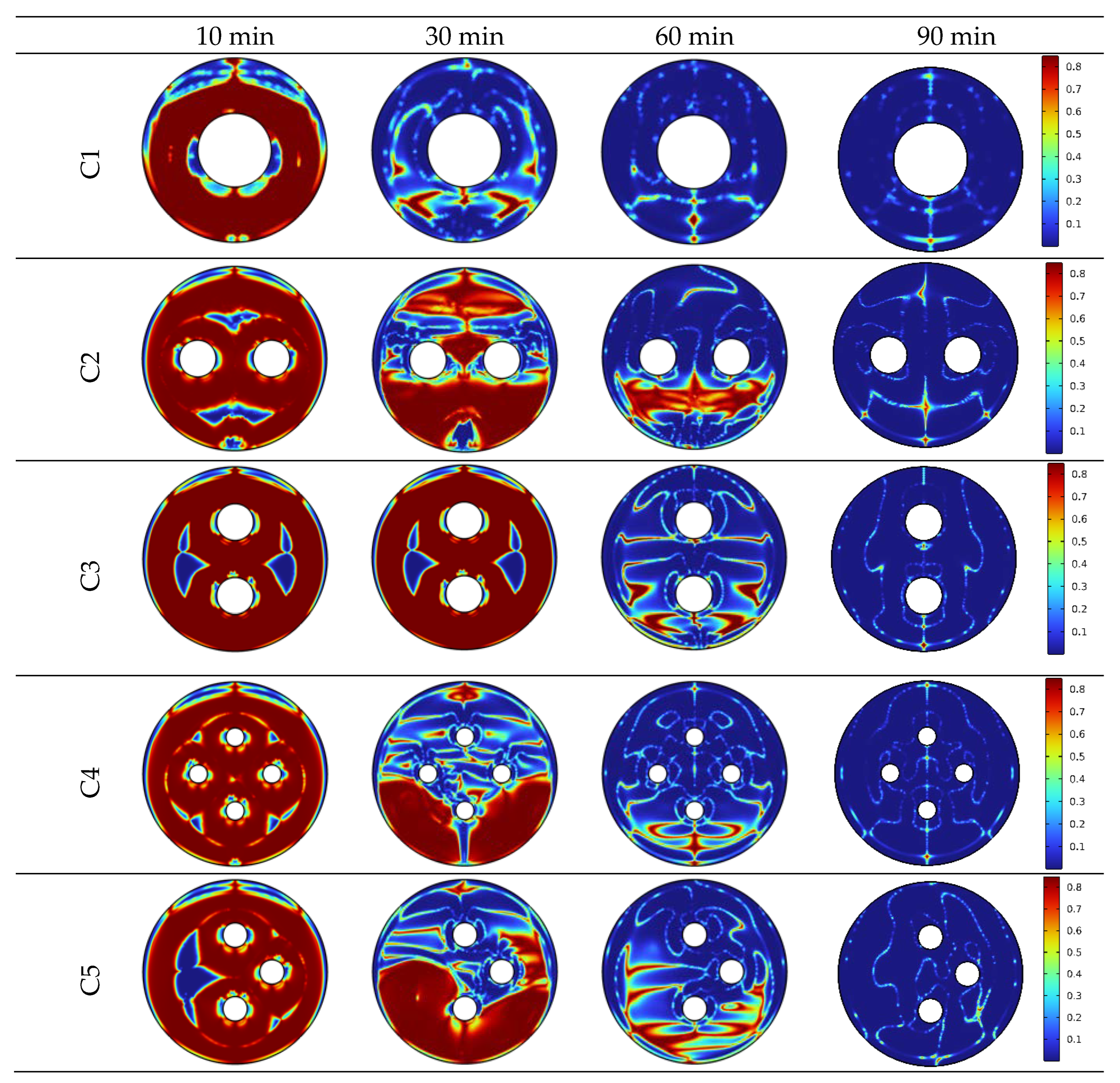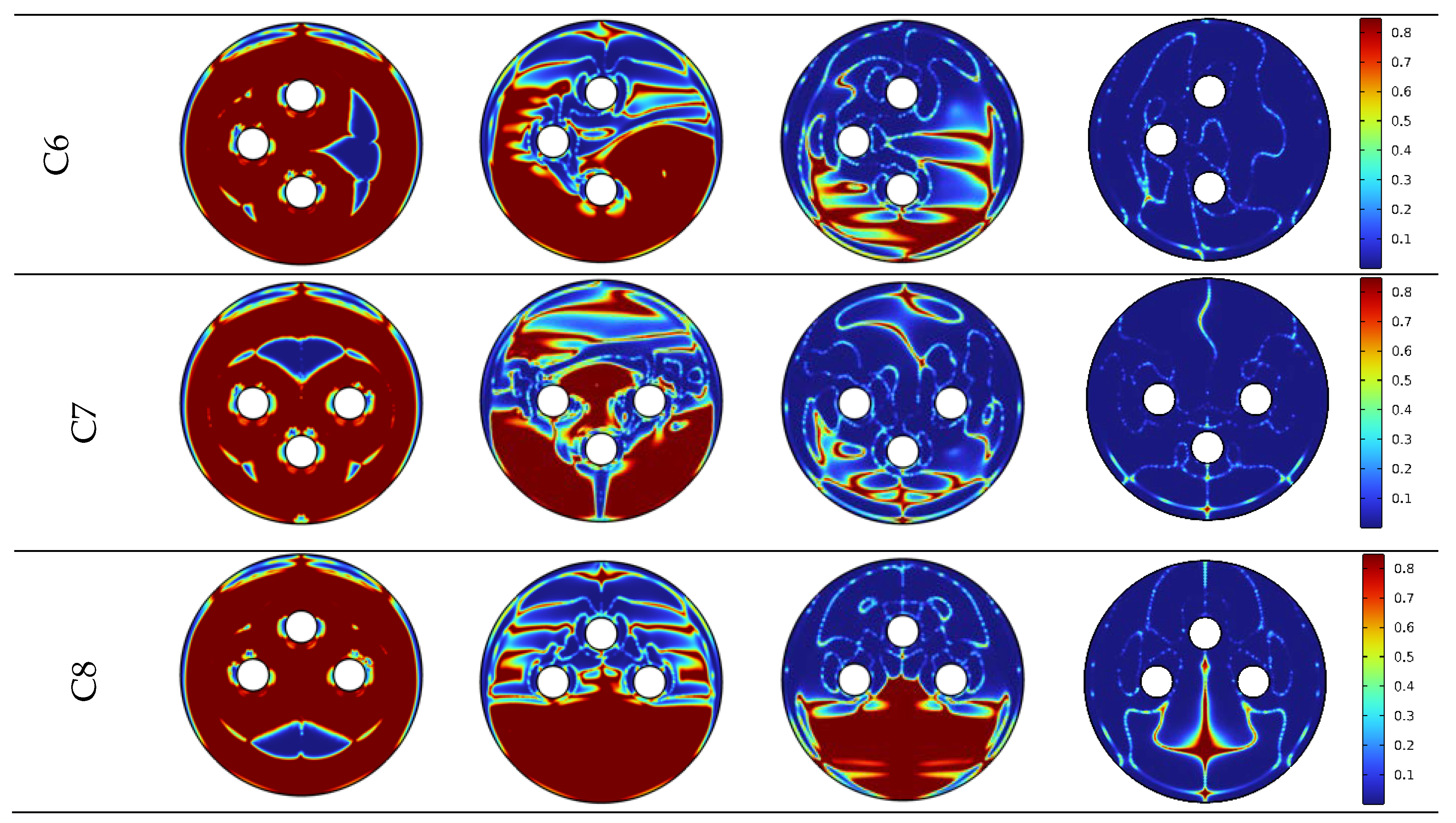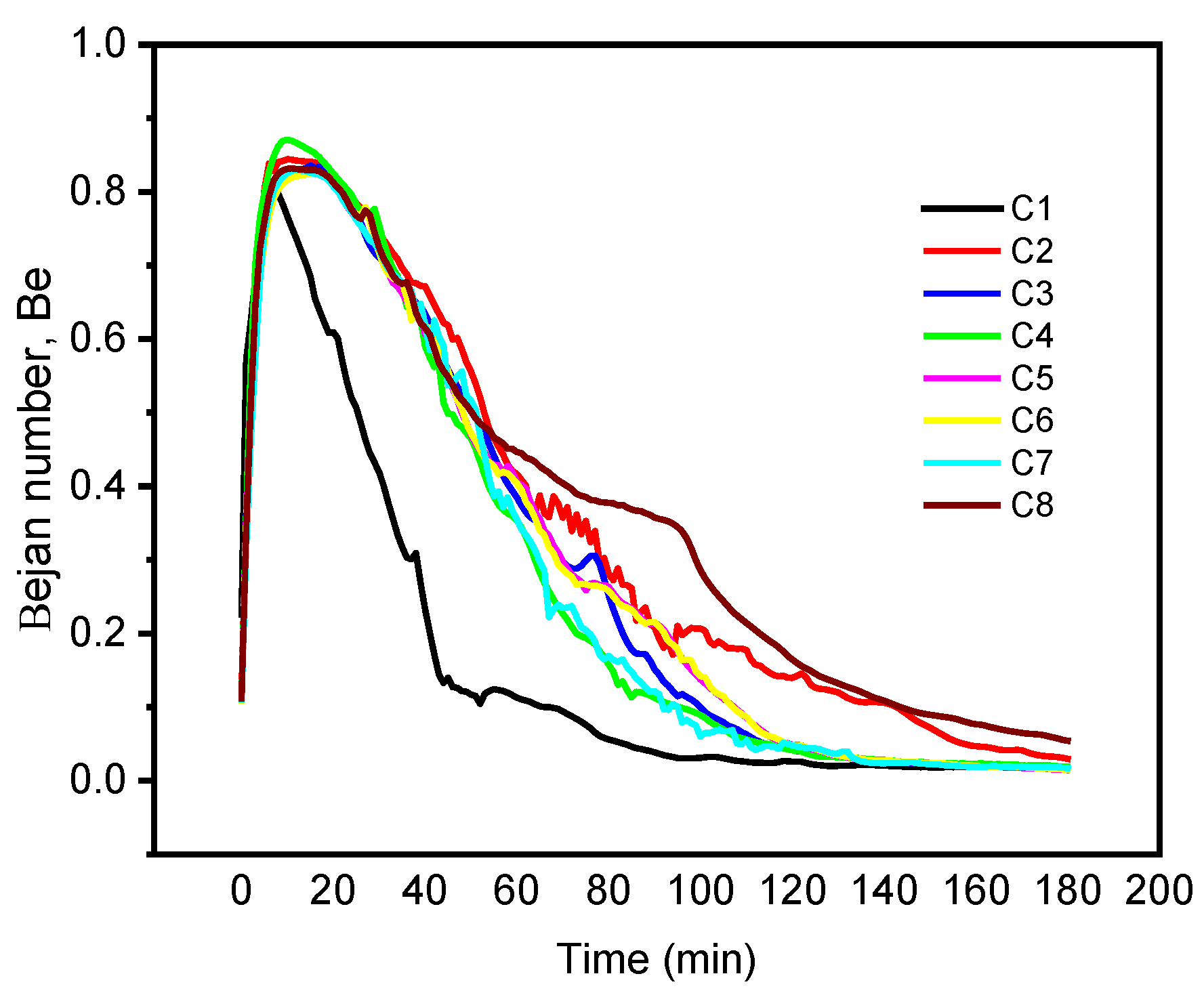1. Introduction
Global energy usage growth, coupled with concerns about supply and environmental impact associated with conventional energy sources, puts the world on the verge of an energy crisis within the next two or three decades [
1,
2]. Solar energy is an excellent option and can be implemented in many parts of the globe. This form of energy is sustainable and everlasting. It has numerous uses in heating and electrical production. However, seasons, time of day, clouds, dust, haze, and obstructions all affect solar energy production. These create an enormous demand for energy storage in solar energy systems to store energy during periods of high solar irradiance for subsequent applications whenever there is demand while solar output is insufficient. Solar energy systems may be more dependable and efficient with energy storage systems related to reducing the demand–supply imbalance. The various energy storage methods that have been suggested for building effective and inexpensive energy storage systems include compressed air energy storage, pumped-storage hydropower, and flywheel energy storage, among others.
Thermal energy storage (TES) is one of the most cost-effective techniques for storing energy [
3]. Due to small temperature changes throughout heat transmission and their high energy storage density, phase change materials (PCM) are the ones that are utilized most frequently in such systems. The technique enables the storage, transmission, and application of thermal energy as PCM absorbs and releases considerable amounts of latent heat storage (LHS) during phase shift. This process occurs when the PCM goes from one phase to another. Based on material qualities, PCM may be classed as organic, inorganic, or eutectics. In recent years, various research has been performed on employing PCMs in LHS systems for applications such as buildings’ thermal comfort, solar energy [
4,
5], water heating, and electronic cooling [
6,
7]. PCMs are selected for such applications based on the system’s operating temperature. Cunha and Eames [
8] investigated various PCMs at different temperatures and found that salt hydrates and organic compounds were appropriate for temperatures below 100 °C, inorganic salt hydrates were suitable for temperatures between 130 °C and 1250 °C, and potassium and sodium were suitable for temperatures greater than 170 °C. PCMs are widely recognized for their poor thermal conduction; this can be improved by adding fins [
9,
10], nano-enhanced PCM (NePCM) [
11,
12], and metal foams [
13]. At the moment, adding nanoparticles to fluids and PCMs is a new idea that has been used in a lot of different industries [
14,
15]. Nevertheless, implementation remains a major obstacle [
16,
17].
Generally, the cylindrical PCM containers are classified into three types: pipe models (with the HTF contained inside the cylinder), cylinder models (with the HTF external to the cylinder), and shell and tube models (which include many parallel tubes). Besides the previously stated methods for enhancing PCM thermal conductivity, altering the shape of PCM containers is an additional useful method for providing a broad range of design alternatives for improved thermal performance of the TES. Kibria et al. [
18] studied the heat transmission between PCM and HTF using a shell and tube system of varying diameters and operating circumstances. They discovered that whereas the HTF intake temperature substantially influenced the PCM liquid percentage, the mass flow rate had little effect. Additionally, they discovered that as the pipe diameter rose, the melting time dropped, and the temperature differential between the HTFs increased. Bazai et al. [
19] attempted to optimize heat transmission of circular-elliptical double pipe TES numerically. The authors explored the effects of various values of various factors values (such as pipes’ diameter and position). They discovered that for a small aspect ratio such as 1/3, the charging rate and the efficiency were improved by increases of 61% and 26%, respectively, when compared to an aspect ratio of 1. Talebzadehsardari et al. [
20] investigated the optimal configuration and positioning of airflow pipe locations during the solidification process of a PCM inside a porous container. The authors discovered that for a faster discharging rate with a 0.51 m HTF tube length with a single air channel, the discharging rate improved by 57%, the exit temperature enhanced by 38%, and the temperature variance between both ends of the discharging rate improved by 3 times when compared to the unit with the straight air tube. Ghalambaz et al. [
21] employed the Taguchi method to find the optimum position of the tube bundle for enhancing the thermal performance of TES. The TES system was a rectangular-shaped shell incorporating tubes carrying the HTF. Depending on the spaces between the tubes, 16 different cases were numerically investigated. The results revealed that by changing the tube bundle position, an improvement of 28% could be achieved at no additional cost. In another study, Ghalambaz et al. [
22] also applied the Taguchi method for optimizing the melting process on NePCM inside a shell and tube heat exchanger. The tubes were of a petal shape. The authors investigated the influence of the tubes’ geometric shape on the melting process. They also studied the impact of the nanoparticles type by using two different nanoparticles: Cu and GO nanoparticles. The results indicated that the contribution of the petal tube amplitude in the stored energy was 41%, while nanoparticles only contributed 5–6%. The impact of the dual PCM configuration on the thermal performance of a horizontal shell and tube TES was numerically examined by Mozafari et al. [
23]. TES was divided into equal sections that contained different PCMs, left/right sections, lower/upper sections, and annulus-shaped sections. Their findings indicated that optimizing the section configurations improved the thermal performance of TES by up to 15%. Yang et al. [
24] numerically examined the impact of fin parameters on the melting duration of PCM inside TES. The thermal performance of the TES when using uniform fins was compared against the case of using non-uniform fins in terms of fin position and fin pitch. It was discovered that the melting time might be cut by 62% by using non-uniform fins, while also improving the melting uniformity by 84%.
The previous assessment of the literature demonstrates that optimizing the geometrical parameters could significantly improve the thermal performance of shell and tube TES. This article endeavors to improve the thermal performance of a PCM-based triplex-tube latent heat storage exchanger (TTHX) by investigating the impact of the configuration of the tubes using a 2D model. The novelty of this paper is exploring splitting the hot fluid tube into multiple tubes across the PCM region or keeping them as one larger tube in the middle of the PCM shell to provide the heating required for PCM to expedite the melting time and increase energy storage. A larger heat transfer area for the single tube is used, while a multiple tubes scheme is used for more heating distribution and covering the bottom of the storage unit to improve the buoyancy effect. Eight different configurations depending on the number of tubes and tube positions were numerically examined. In addition, the entropy analysis in terms of Bejan number (as the participation of heat losses to all irreversibility sources) is discussed and analyzed for the eight different configurations. To isolate the impact of melting rate, the volume of the PCM in the eight studied was kept constant.
2. Problem Description
The problem under discussion considered a PCM-based triplex-tube latent heat storage exchanger (TTHX) incorporated in a domestic water heater for energy saving. A domestic water heater with a heat exchanger and PCM is shown in
Figure 1. A number of different geometries have already been employed in the numerous applications of TES systems. Because of their distinctive characteristics, cylindrical TES is more commonly employed. The charging process of PCM happens during the day, whereas the procedure of discharging is carried out throughout the night.
Figure 2 illustrates a triplex-tube latent heat storage exchanger (TTHX) unit in the shape of shell-and tubes. The internal, middle, and external tubes have diameters of 20 mm, 50 mm, and 62.5 mm, respectively. Copper is used for the inner tube. n-octadecane was utilized as the PCM in this investigation since it has a melting point of 301.2 K. The PCM is deposited in the middle tube to improve heat transfer and expedite the PCM melting process from the outer and inner surfaces of the PCM shell. The characteristics of PCM and copper are provided in
Table 1. The initial temperature was deemed 300.2 K, and in each of the instances, the volume was adjusted so that the total amount of PCM stored in the system remained the same.
Figure 3 illustrates the produced mesh for the chosen shape. For greater viewing, the produced mesh has been exhibited for various areas of the TTHX individually.
2.1. Governing Equations
The modeling of PCM behavior in a triplex-pipe has been carried out utilizing the enthalpy porosity approach, with the standard tube being split into two, three, and four tubes within the PCM shell. The simulations were based on the following set of assumptions [
6]:
The flow of liquid PCM is incompressible and laminar;
We have not taken into account the heat that is lost via the outside shell as it is insulated;
The viscous dissipation impact is ignored;
The Boussinesq approximation was used to take into account the impact that density fluctuations have. As a result, the density of PCM was considered to be averaged for both solid and liquid forms;
The simulation of the phase change process that occurs in a multitube heat exchanger is accomplished by employing the enthalpy porosity approach models [
25,
26].
Based on these assumptions, the governing equations can be expressed as:
Enthalpy of the material is as follows:
denotes PCM sensible enthalpy, and
denotes the latent heat of the material.
and
are determined using the following formulas:
denotes the latent heat of the material; therefore,
ranges from 0 (solid) to
(liquid). The liquid fraction equation read [
27]:
The NEPCM heat capacities read:
The Boussinesq term read:
The nanoparticles’ volumetric fraction is denoted by
, and subscript
is used for NEPCM,
for NEPCM, and
for PCM. The effective dynamic viscosity of the NEPCM is presented by the Brinkman equation [
28]:
The thermal conductivity of the solid NEPCM is given by Maxwell [
29]:
Moreover, the NEPCM’s effective thermal conductivity is as follows:
where
, thermal conductivity enhancement term is given by:
The value of the constant
C is determined based on the research carried out by Wakao and Kaguei [
30]. The NEPCM latent heat read [
31]:
For including the impacts of phase change in the convective heat transmission,
Darcy’s law damping term is included in the momentum equation, Equation (2):
In the present paper,
is a constant value equal to
. A mushy zone constant is a big number ranging from
[
32].
The generated entropy as a result of the flow irreversibility (due to friction factor) is given by the following equation
The generated entropy as a result of the heat transfer is given by the following equation
Considering the heat transfer originated form of entropy generation, the entropy generation ratio by the heat transfer to total entropy generation rate is denoted by
Be number and is determined using the following equation
2.2. Grid Independency and Method Validation
The result obtained for phase melting progression in a square cavity was compared to the numerical results provided by Arasu et al. [
33] in
Figure 4A in order to verify the implementation of the mathematical modeling of melting and the solution procedure described. The present findings are in great agreement with those reported in the literature, confirming the fundamental validity of the numerical model.
The geometry representing the system was created in 2D using COMSOL Multiphysics. In
Figure 4B, a mesh dependency analysis was conducted to find the optimal element size to employ; in order to provide a solution that is independent of the accurate mesh and to reduce the amount of time spent on the overall computation, the average liquid percentage parameter was selected to be explored.
All simulation studies in this work were carried out using grid G2, which was chosen on the basis of the mesh dependency study results (shown in
Figure 4B). The mesh dependency analysis is made possible by comparing the average liquid fraction over time for the various grid sizes shown in
Table 2.
3. Results and Discussion
TES unit in the shape of shell-and tubes filled with PCM (n-octadecane) is investigated in this study to help store more thermal energy for different applications, including a solar collector to be used upon need during less irradiation or night. The typical tube is divided into two, three, and four tubes inside the PCM shell to improve the melting process. The number and distribution of the tubes are investigated.
3.1. Temperature Distribution and Heat Transfer Behavior
The PCM temperature distribution of eight designs of shell-and-tube storage units is presented in
Figure 5 for a constant volume of PCM. Heat transfer takes place by conduction. Once the melting process propagates from the hot surfaces to the neighboring regions, the convection heat transfer is dominant in these regions. Moreover, the melted and hot regions are available above the tubes because of the buoyancy effect. The first look at
Figure 5 shows that the enhanced heat transfer and high-temperature values are not related to the number of tubes; rather, the heat transmission area and the existence of hot surfaces at the bottom of shell regions are the most important factors. The first factor (heat transfer area) is shown in configuration 1 (C1) as one big tube with a higher surface area that transfers more heat to the PCM, expediting the melting process and increasing the temperature values quickly. Configurations C2 and C3 have lower tube areas than C1 but with different distributions inside the PCM shell. C3 performs better than C2 due to the vertical arrangement of tubes. In such a way, the lower tube covers large regions at the bottom and exploits the buoyancy effect and free convection heat transfer, so the melted portions of PCM with higher temperatures rise up. C5, C6, and C7 show three tubes with different arrangements. Since the three configurations have the same heat transfer areas, the enhancement of temperature values for C7 is higher due to the presence of two tubes in the middle and, importantly, one tube at the lower part of the shell, so the buoyancy effect works efficiently to cover the majority of the shell regions. Thus, C7 could be considered a good design. Furthermore, to split a tube into four tubes and attribute it on all sides (up, down, right, and left), as shown for C4, the hot temperature values progress quickly. It could be shown that case C4 comes third after cases C1 and C7.
It is also noticed that case C1 needs a round 45 min to have a higher temperature in the entire shell (~308 K) with a small difference from the bottom (~306 K). However, the other good cases, such as C4 and C7, achieve that for a higher time.
A more explicit illustration of the impact of time on the temperature and heat transfer (in terms of Nusselt number) is depicted in
Figure 6.
Figure 6a shows that the average temperature reaches 307.5 K for case C1 in 45 min while about 72 and 69 min are needed for reaching the same temperature for cases C4 and C7, respectively.
Figure 6b depicts the low values of the average Nusselt number for C1 due to reaching a high temperature closer to the value of the heating temperature. Thus, the temperature difference is small, resulting in minimizing the needed heat transfer. This behavior is preferable for saving energy quickly by changing to the liquid phase of PCM. All cases get almost Nu = 0 at time = 110 min due to reaching the heating temperature in the entire PCM shell (ΔT = 0).
3.2. Liquid Friction Distribution
Figure 7 and
Figure 8 show the contours and temporal profiles of the liquid fraction as a direct indication of the melting process for the eight designs of the PCM shell-and-tube storage unit. With a heating process from the inner tubes and outer shell surface, the melting process is expected to be fast in all cases. However, because of the heat transmission area and buoyancy effect described in the previous figures, the shell-and-tube C1 shows the best design for obtaining a quick melting process. Design C7 also shows an expedited melting process. The contours demonstrate the melting process starts closer to the hot surfaces, and then once there is a sufficient liquid of PCM, the buoyancy effect has a significant impact on flow circulation and the better melting process at the top regions. For more than 90 min, all configurations have PCM in the liquid phase. The distinct hot and cold regions appear at a time of 45 min. At this time, the higher surface area case (C1) shows the best melting process among others. With less surface area, C7 also shows good melting behavior by having one tube at the bottom and two at the middle sides.
Figure 8 emphasizes the fact that case C1, followed by C7, is the best over the melting time. For example, C1 reaches complete melting at 47 min, while 76 and 98 min are needed for C7 and C8, respectively. Compared to C8, configurations C1 and C7 show a faster melting process by about 2.1 and 1.3 times, respectively. Thus, one large tube is preferred for the inner tubes; C1 has no competitor, while when many tubes are required, C7 could be recommended. Another important factor that stands for C1 is the low-pressure drop of the flow inside higher-diameter tubes. Therefore, C1 is strongly recommended by this study for shell-and-tube thermal storage units.
3.3. Bejan Number and Entropy Generation
As the melting process is associated with latent energy consumption and heat losses besides the flow resistance of free convection, the entropy generation analysis could be helpful in highlighting the wasted energy, which could be avoided by a proper design. Bejan number is used as a dimensionless factor to represent the dominance of heat loss over the flow friction. Thus,
Figure 9 and
Figure 10 are devoted to this important parameter.
The contours of the Bejan number for the investigated eight storage units are displayed in
Figure 9. The hot (red, higher Be values) regions show the supremacy of thermal entropy generation, while the blue regions are for the significant influence of the flow friction. Since the melting process consumes more energy than the sensible one, the phase change process has more thermal entropy generation. For this fact, one could argue that the hot regions are those showing progress in the melting process. Once the melting process ends at a region, the buoyancy effect takes place, and the circulated flow has more flow resistance, then blue regions appear (flow resistance regions). In this regard, the configurations that have a more blue color mean the melting process has almost been accomplished. It is clear for C1, C4, and C7 at 30 min that the Bejan number has lower values in the majority of the PCM shell, while other cases have more red color due to the presence of the melting process.
As time passes, the melting process is still taking place in the bottom regions of all storage units due to the smaller buoyancy effect which enhances the heat transfer to provide sufficient latent heat for the phase change process. Thus, the bottom regions delay the melting process. The designs C1, C7, and C4 could be used to avoid this. Moreover, fins would be recommended to be added to the bottom of the shell or between the bottom surface of the shell and the inner tubes.
Figure 10 repeats the same behavior of the contours that C1 has lower Be values, followed by C4 and C7 due to the expedited melting process and reduced heat losses. Configuration C1 has a distinctly quicker melting process than others from the start of the melting process, with the lowest thermal entropy generation values, while C4 and C7 show themselves after 55 min. The tube distribution cases (except C1) have a melting process at the top regions over the early time (<55 min), so it is difficult to select one of them as the best PCM shell. Thus, the melting process at the shell bottom is the key factor that shows which configuration has a quicker melting process for a time > 50 min.
For lower entropy generation due to heat losses, increased heat transfer area and good tube distribution should be considered. Fins could be suggested to be added to the bottom regions of the PCM shell.
4. Conclusions
This study conducted a thermal and entropy analysis of a TES unit in the shape of a shell-and-tube filled with PCM n-octadecane. Eight configurations of the shell-and-tube unit are compared. The basic design considers one big tube in the middle of the PCM shell with a higher heat transfer area, while the other cases have two, three, and four tubes inside the PCM to enhance the melting process. The results are presented in terms of temperature contours, Nusselt number profiles, liquid fraction contours and profiles, and Bejan number contours and profiles. The findings of this study highlight that the temperature values, heat transfer rates, and melting process are better when the heat transfer area is bigger, such as in configuration 1 (C1). When the tubes are more than two, the existence of one tube (at least one) at the shell bottom could significantly improve the heat transmission rates and melting process. For example, C1, with a higher surface area, shows a better melting process by more than 62% compared to other cases, and the good tube distributions, such as C7 and C4, show a >12% quicker melting process than the rest of the configurations (except C1). Furthermore, C1 has the lowest heat transfer losses and thermal entropy generation (lowest Bejan values). C3 and C7 display lower Be values after 55 min of the melting process, while other cases have higher values. The trade-off between the larger heat transfer area of a single tube improving the heat transfer by buoyancy effect in the bottom region by putting a smaller tube (for the multiple tubes scheme) showed that the larger heat transfer area is coming first before the buoyancy effect.
The present study focused on the use of one large tube or the splitting of it into multiple tubes. However, fins could be attached between tubes to improve the melting process. Thus, it is recommended to investigate the effect of fins on tube distribution and melting process. Moreover, different PCM materials with different input conditions could be investigated. A three-dimensional storage unit could be modeled for a vertical position to have a greater buoyancy effect since the current study is concerned with the horizontal storage unit (for which the 2D model is sufficient).


